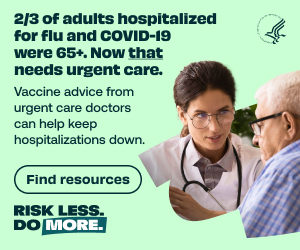 The size of the bills people receive for emergency care can seem somewhat remote to most of us. It’s easy to resign ourselves to saying, “the patient’s insurance will pay for it,” or “the government will pay for it.” But it is truly hard to witness some of the more egregious cases of price gouging in emergency care and remain detached.
The size of the bills people receive for emergency care can seem somewhat remote to most of us. It’s easy to resign ourselves to saying, “the patient’s insurance will pay for it,” or “the government will pay for it.” But it is truly hard to witness some of the more egregious cases of price gouging in emergency care and remain detached.

The size of the bills people receive for emergency care can seem somewhat remote to most of us. It’s easy to resign ourselves to saying, “the patient’s insurance will pay for it,” or “the government will pay for it.” But it is truly hard to witness some of the more egregious cases of price gouging in emergency care and remain detached.
Recently, my brother, a veterinarian practicing in northern New Jersey, called to report the experience of one of his veterinarian colleagues. While at work one day, she received a call from her husband that her son had been bitten by a relative’s dog, sustaining two small puncture type lacerations on the forehead. She advised her husband to take the child to the local hospital ED . . . to have him seen by a plastic surgeon. First mistake. Every emergency physician who works in a well-to-do suburban ED has, without doubt, had to deal with this challenge on a regular basis.
Unluckily for the family, a plastic surgeon was available to see the child in the ED. After both small wounds were closed, only one requiring a two layer closure, the patient received a bill from the ED for a little less than $1,000. Then came the plastic surgeon’s additional bill, weighing in at a whopping $5,800. After wrangling with the insurance company for months they finally paid the surgeon $1,750, but then he balance-billed the patient for the remaining $4,050.
How did this happen? A concerned but uninformed patient (parent in this case) asked for an unneeded service, not having any concept that the charge would be unfathomable. But what parent would price shop when their child’s appearance was at stake? This was a classic “gotcha”. Most patients believe that while emergency care is expensive, it will at least be somewhat “reasonable.”
Let’s look at how this well-intentioned but medically naive parent made a series of incorrect assumptions. First, they might have assumed that the emergency physician would have tactfully advised the parent whether he felt comfortable closing the wound. Acting in such a way is not solicitation, but rather patient advocacy, helping them make an informed decision. But while most of us trained under plastics to do repairs the same way a surgeon would, the emergency physician, in most busy EDs, might not even do simple facial repairs anymore, relegating these tasks to suture techs or PAs. So he may have felt it inappropriate to suggest a lesser trained provider. Second, the EP might have been unaware of what his ED would charge for the service, let alone what the plastic surgeon would charge. Had the EP brought up the question of capability and price, they would have allowed the patient to make an appropriate “value decision.”
The parent also assumed that, because the laceration was on the face, a plastic surgeon would do a better job suturing the wound. How often do we, as clinicians, explain to patients exactly what must be done and how it is done, so that they can make an informed decision? The parents assumed that a higher fee could be expected from the plastic surgeon. But 15-20 times what the emergency physician would have charged and well beyond what his insurance company would pay? Would that change the mind of even the most overprotective parent. I suspect so.
God forbid that this child had not been insured! Unfortunately, it would have illustrated yet another inequity. In that case, the emergency physician would have probably advised that a plastic surgeon wasn’t needed for these wounds and was unlikely to agree to see the patient anyway.
And even as I point out the exorbitant surgeon’s fee, I have to comment on the ED “room” fees – the price tag to walk in the door. What possibly could have been done for this child that would warrant a physician and room fee of almost $1,000? A suture set was used, the emergency physician made a phone call to get a plastic
surgeon and did a cursory exam.
Of course, when cases like these are discussed, the response is often, “There is a big difference between charges and cost.” And that is correct. But it is time that we have intelligent discussions of both issues. The charge for a service may include a lot more than the intrinsic cost of that service. That’s a given. But shouldn’t they be at least in some way related?
CMS is now attempting to lower what they pay hospitals in facility fees. For the past ten years each hospital has set its own facility fees – five levels – based on whatever criteria it wanted. Unlike the rigid “guidelines” surrounding physician charting requirements, the only requirement regarding facility room charges is that they be consistently applied – no matter how irrationally they are determined.
The most recent proposal by the feds is to pay a flat fee – say $220 for all Medicare patients. This move, which may take effect as early as January 2014, will be derived from averaging all of the facility fees paid in the prior year. As can be imagined, the hospitals are saying this may shortchange the hospitals with the sicker patients, which is probably true. Imagine one patient with a rash parked in a room for an hour being charged the same as a patient that requires intense monitoring. So now there will be more cost shifting to all the other charges for medications and nursing procedures. A bag of saline, whose intrinsic cost might be a few dollars, will be charged out at well over $100, with the same true for the IV tubing, extension tubing, IV catheter and dressing added in, plus the separate fee charged to have a nurse start the IV.
The ED “facility fees” that are charged by hospitals can be very aggressive, easily $1,000 in some hospitals for minimal treatment. But hospitals defend these charges by reminding us that they have to treat all comers, have a huge investment in technology, and have to be capable of providing all manner of services including inpatient bed availability. Moreover, since in most states Medicaid payments cover even less than the intrinsic cost of care, (and Medicare is barely better) hospital EDs operate with a “Robin Hood” mentality – robbing from the rich to pay for the poor.
The bottom line is this: most emergency physicians work very hard for their patients, often in environments that are very challenging. But many are unaware of the financial inequities that our patients often endure. Increasing awareness of these issues may serve as a motivator to advocate for more transparency. Every emergency physician should periodically look at the total bills their patients receive. We can’t be expected to act responsibly on behalf of our patients and the healthcare system if we practice in a vacuum oblivious to the economic consequences of our actions.
Richard Bukata, MD
Editor of Emergency Medical Abstracts (www.ccme.org)









